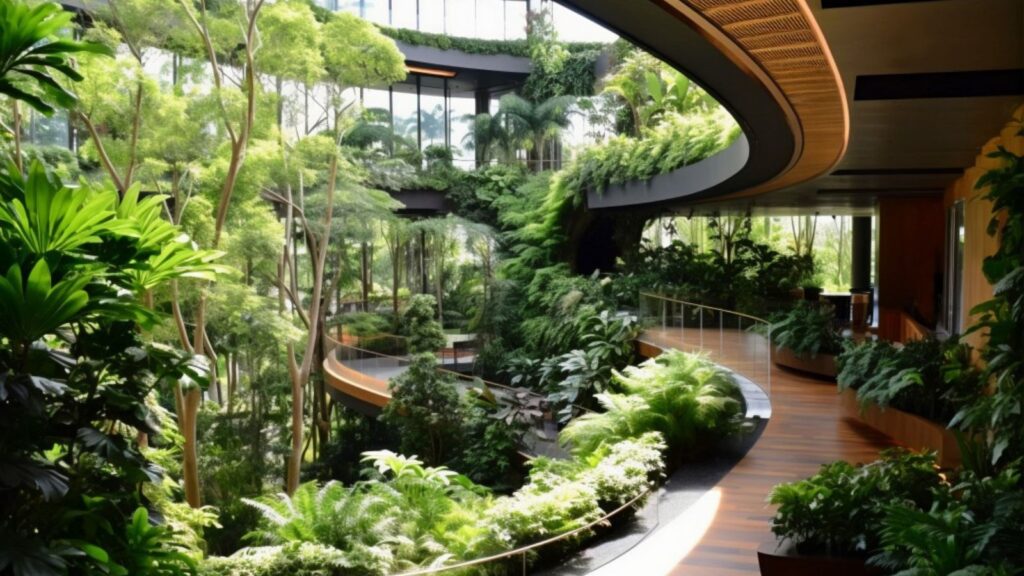This innovative design philosophy goes beyond merely incorporating plants into buildings. It’s about creating a seamless blend of architecture and nature, letting them interact in ways that enhance our lives. From the use of natural materials to the integration of natural light and ventilation, Biophilic Architecture is transforming the way we think about design.
So, if you’ve ever wondered how architecture can contribute to a healthier, more sustainable future, you’re about to discover the fascinating world of biophilic design. It’s more than just a design concept; it’s a new way of living and interacting with our built environment.
Biophilic Architecture
Biophilic Architecture isn’t just a fad tossed around by design enthusiasts; it’s a deep-rooted philosophy that’s transforming our concrete jungles into sustainable habitats. So, what does this concept entail? Let’s delve deeper.
Known as “architecture for life”, biophilic design integrates natural elements with the built environment. It’s not merely about green roofs and potted plants; the approach extends beyond these common themes. It weaves nature into every fibre of architectural design, from materials to layouts, from colours to the flow of space.
One might wonder, “How is it achieved?” Remember, Biophilic Architecture doesn’t try to replicate nature, but instead focuses on evoking the emotional connections to nature that humans inherently seek.
Designers accomplish this through two key principles:
- Direct Connections: Incorporating elements such as natural lighting, fresh air, plant life, water bodies, and the use of natural materials in construction.
- Indirect Connections: Implementing nature-inspired textures, patterns, or colours in design, views of nature through windows, or even mimicking natural shapes and forms in the built structure.
It’s about creating an architecture that supports our psychological well-being, our need for a sense of place, and our connections with the environment. Biophilic design aims at increasing connectivity to the natural world through the use of direct, spatial, and temporal environmental phenomena.

Principles of Biophilic Design
Biophilic design leverages the intricate pattern of human-nature relationships. It’s founded on seven basic principles that help building designers, urban planners, and landscape architects to create spaces that instigate a deep emotional connection with nature.
Connection with Natural Systems is the first principle. It’s not about replicating nature in architecture but understanding how natural systems operate and demonstrating that within the builds. Think of bird’s nests or honeycomb structures. They offer inspirations of structures that are both functional and aesthetically appealing.
The second principle is Biomorphic Forms and Patterns. The emphasis here is on organic shapes and forms that inspire from the natural world. The use of patterns that we see in trees, seashells, flowers, and even snowflakes can stir feelings of awe and interest, subsequently fostering a connection with nature.
Next, we have the Use of Natural Materials. It’s important to note that using natural materials isn’t about stripping nature bare. It involves the use of sustainable practices in obtaining these materials, and in using them within buildings, it offers people tactile and sensory experiences that remind them of nature. A wooden table or stone flooring can create a natural feeling more effectively than their synthetic counterparts.

Benefits of Biophilic Architecture
Biophilic Architecture offers a myriad of benefits, from stepping up productivity to enhancing well-being, and improving air quality to boosting creativity.
Improved Well-being: Perhaps the most prominent benefit of biophilic design is its impact on occupants’ well-being. Spaces that mimic nature can have calming effects, reducing stress levels of inhabitants. By stimulating senses via natural features such as the sound of water or sight of greenery, our spaces become more soothing and rejuvenating.
Enhanced Productivity: Studies indicate a correlation between nature-inspired environments and increased productivity. Natural light, indoor plants, and engaging landscapes can improve alertness, focus, and cognitive function. A clear head leads to better problem-solving capabilities, faster decision-making, and increased creativity.
